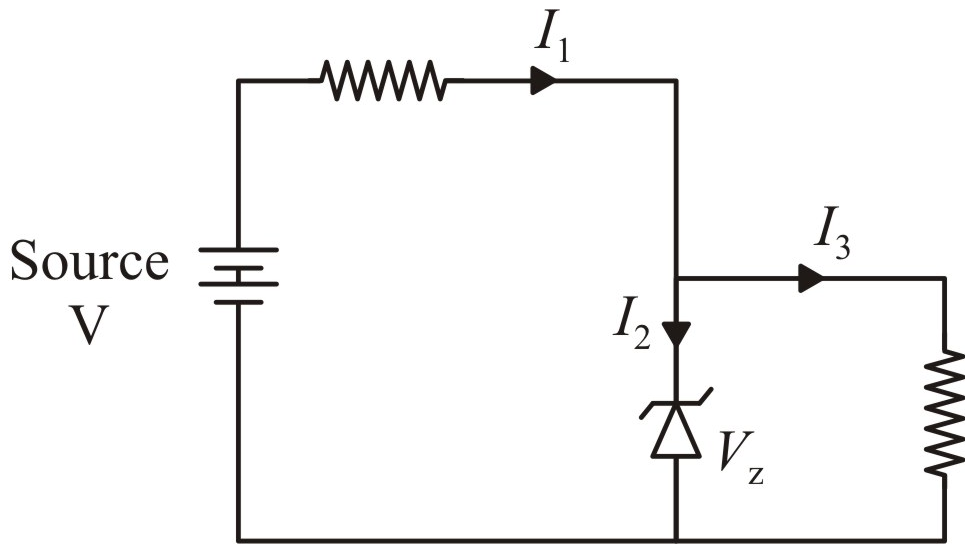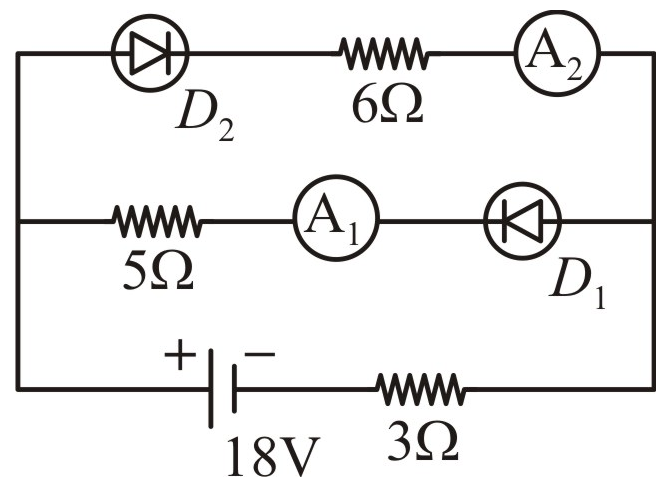A potential barrier of 0.50 V exists across a p-n junction. If the depletion region is m wide, the intensity of the electric field in this region is:
1.
\(1.0 \times 10^6 \mathrm{~V} / \mathrm{m}\)
2.
\(1.0 \times 10^5 \mathrm{~V} / \mathrm{m}\)
3.
\(2.0 \times 10^5 \mathrm{~V} / \mathrm{m}\)
4.
\(2.0 \times 10^6 \mathrm{~V} / \mathrm{m}\)
The current through an ideal p-n junction diode shown in the circuit will be:
1. 5 A
2. 0.2 A
3. 0.6 A
4. Zero
When a forward bias is applied to a p-n junction, then what happens to the potential barrier , and the width of charge depleted region x?
| 1. | \(V_B\) increases, x decreases | 2. | \(V_B\) decreases, x increases |
| 3. | \(V_B\) increases, x increases | 4. | \(V_B\) decreases, x decreases |
An LED is constructed from a \(\mathrm{p\text{-}n}\) junction diode using \(\mathrm{GaAsP}\). The energy gap is \(1.9~\text{eV}\). The wavelength of the light emitted will be equal to:
1. \(10.4 \times 10^{-26} \text{m}\)
2. \(654~ \text{nm}\)
3. \(654~ \text{m}\)
4. \(654\times 10^{-11}~\text{m}\)
A Zener diode is shown in the following circuit diagram. When the source voltage fluctuates such that , then:
1. all the current I1, I2 and I3 change.
2. only I1 and I2 change and I3 remains constant.
3. only I1 and I3 change and I2 remains constant.
4. all the currents remain constant.
What is the reading of the ideal ammeters A1 and A2 connected in the given circuit diagram, if junction diodes are ideal?
1. 2 A and zero
2. 3 A and 2 A
3. 2 A and 3 A
4. Zero and 2 A
Which of the following graphs may correctly represent the variation of current (l) with potential difference (V) across a zener diode?
| 1. |  |
2. |  |
| 3. |  |
4. |  |
The combination of gates shown in the diagram is equivalent to:
1. OR
2. AND
3. NAND
4. NOT
A Zener diode is used to obtain a constant voltage. If applied voltage \(\text V\) changes, then:
(\(\text V\) is more than Zener voltage)
| 1. | \(i_{1}\) and \(i_{2}\) change. |
| 2. | \(i_{2}\) and \(\text V_{0}\) change and \(i_{3}\) remains constant. |
| 3. | \(i_{2}\) and \(\text V_{0}\) don't change while \(i_{3}\) changes. |
| 4. | \(i_{3}\) and \(\text V_{0}\) don't change while \(i_{2}\) changes. |
In the given circuit, the power developed in 2 k resistor is:

1. 36 mW
2. 12 mW
3. 144 mW
4. 72 mW







